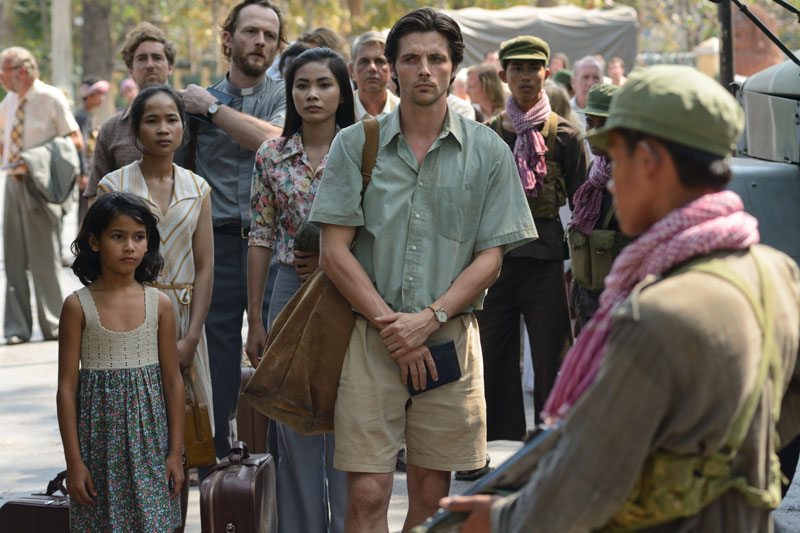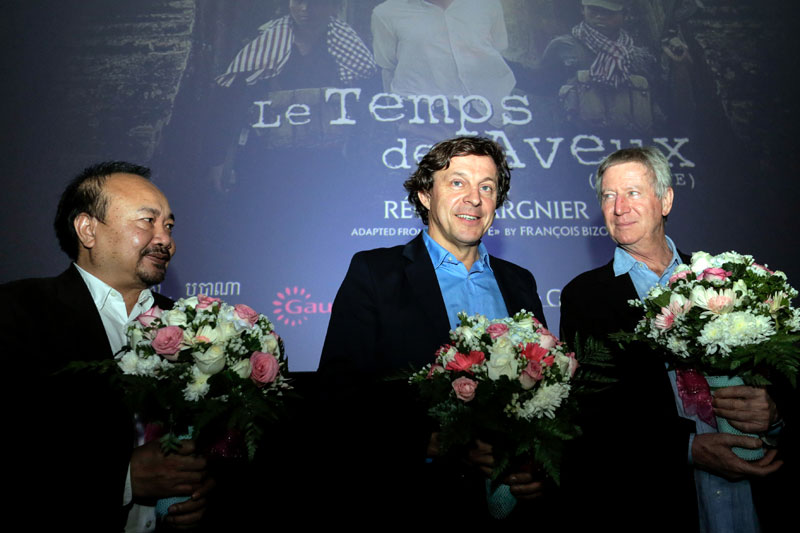As head of the Khmer Rouge regime’s secret police, Kaing Guek Eav, best known as Duch, presided over the torture and murder of over 12,000 people at S-21 prison, which became notorious for the cold atrocities committed there.
But Duch’s earliest experience as a jailer came at the less well-known M-13, a prison camp set up in the early 1970s comprising little more than a handful of modest houses in rural Kompong Speu, shaded by a few trees.

It is this site that forms the setting of the new feature film “The Gate,” whose Cambodian premiere took place last night. One of the most striking aspects of the film is the deceptive tranquility of the countryside that serves as a backdrop for Duch’s cruelty.
The prison camp had a killing ground where the bodies and skulls of executed prisoners lay, but it was hidden from view some distance away from the houses, as one prisoner learned only when he attempted an escape.
This prisoner was Francois Bizot, a French scholar whose 77 days in captivity at M-13 in 1971 are the subject of “The Gate.” The film, entitled “Le Temps des Aveux” in French, is based on Mr. Bizot’s book, “Le Portail,” published in French in 2000 and in English in 2003.
As the film starts in the seemingly peaceful Cambodian countryside of 1971, Mr. Bizot is living in a village at Angkor with his Cambodian wife and daughter. On his way back from a pagoda where he and two Cambodian colleagues had gone to study a Buddhist text, he is taken prisoner by a squad of Khmer Rouge soldiers. Brought to M-13, he is shackled to a pole next to sacks of rice, while his colleagues are kept with the other Cambodian prisoners.
Mr. Bizot remains there with no shelter for sun or rain, undergoing repeated interrogations by Duch, who tells him to write his confession and admit that he is a spy for the CIA. Mr. Bizot denies the charge over and over again.
As the story develops, gratuitous cruelty and senseless killings take place quietly among the greenery and Angkorian sculptures, the peacefulness of the setting underscoring the absurdity of the regime.
Mr. Bizot is one of the very few foreigners to have survived capture by the Khmer Rouge. As can be seen in the film, it was only the relationship he developed with Duch—who became convinced he was not a spy—that saved him. Ta Mok, Khmer Rouge Southwest Zone Secretary, had been set on killing him and made sure that Mr. Bizot’s two Cambodian colleagues, Ung Hok Lay and Kang Son, were executed.
After his release, he remained in the country and was among the last foreigners who took refuge at the French Embassy in April 1975 before being taken by trucks to the Thai border under Khmer Rouge escort. Some scenes in the film cover this part of his story.
“The Gate” was directed with profound commitment to authenticity of settings and atmosphere by Regis Wargnier, a French director with a long list of prizes to his name, including an Academy Award for “Indochine,” an iconic film about the last decades of the French regime in Indochina and the rise of the nationalist movement in Vietnam.

With the help of filmmaker Rithy Panh, who introduced him to Cambodian technicians, Mr. Wargnier made an effort to use Cambodian crew and workers on every aspect of the production, which was filmed in Battambang City and in the Koh Ker Angkorian site in Preah Vihear province.
“They brought us the accuracy, veracity, the authenticity in everything,” he said in an interview Wednesday.
Mr. Wargnier, who spent a year writing and polishing the script, was concerned about finding an actor to portray Duch, as he had to be a Cambodian who also spoke good French.
Kompheak Phoeung, a former translator at the Khmer Rouge tribunal, was contacted by the Cambodia Film Commission and asked to audition. Although he managed the Kok Thlok theater company, he had never performed himself.
“To portray Duch is something that bothered me at first…playing an executioner,” he said Wednesday. “But…I thought, well, someone has to play the nasty, the villain.”
The fact that Mr. Phoeung had spoken to Duch and observed him at length through his work at the tribunal helped him portray his character with authenticity. “This enabled me to grasp some of his fundamental traits,” he said.
The film was shot in the order the story develops, in part because Raphael Personnaz, the actor playing Mr. Bizot, had to lose a significant amount of weight during his incarceration. He lost about 8 kg, which he had to regain immediately for the final scenes, Mr. Wargnier said.
“The Gate” will be presented to the public during the Cambodian International Film Festival held from December 5 through 10, said Cedric Eloy, project manager for the Cambodia Film Commission, which assisted the film production team. It will be shown in French with English subtitles, and a dubbed version in Khmer will later be produced.



